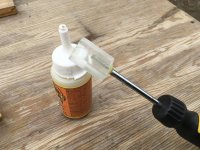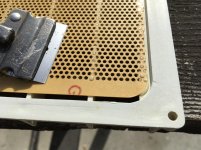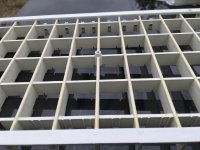Hi,
I'm in the process of replacing diaphragms on my pair of Quad ESL-63.
I have purchased a kit years ago and replaced one diaphragm. Now I finally have some spare time to get back to it and replace all other diaphragm.
Unluckily, the moisture cure polyurethane glue that came with the kit has solidified.
Can you suggest me a good replacement glue I could use to glue the diaphragms to the frame that I can buy here in the States?
I searched a bit on this forum and found some mentions to the following two tapes:
- 3M Adhesive Transfer Tape 467MP
- 3M™ High Performance Double Coated Tape 9088
I have also seen mentioned different opinions if better to use an epoxy that expands or not.
On some sites I found mentions to use a two part epoxy. A quick search on Amazon brings up Gorilla Glue two part epoxy, but seems it does expand Amazon.com: Gorilla 2 Part Epoxy, 5 Minute Set, .85 ounce Syringe, Clear, (Pack of 1): Home Improvement.
Can you suggest a particular model / brand you had success with?
Thanks!
I'm in the process of replacing diaphragms on my pair of Quad ESL-63.
I have purchased a kit years ago and replaced one diaphragm. Now I finally have some spare time to get back to it and replace all other diaphragm.
Unluckily, the moisture cure polyurethane glue that came with the kit has solidified.
Can you suggest me a good replacement glue I could use to glue the diaphragms to the frame that I can buy here in the States?
I searched a bit on this forum and found some mentions to the following two tapes:
- 3M Adhesive Transfer Tape 467MP
- 3M™ High Performance Double Coated Tape 9088
I have also seen mentioned different opinions if better to use an epoxy that expands or not.
On some sites I found mentions to use a two part epoxy. A quick search on Amazon brings up Gorilla Glue two part epoxy, but seems it does expand Amazon.com: Gorilla 2 Part Epoxy, 5 Minute Set, .85 ounce Syringe, Clear, (Pack of 1): Home Improvement.
Can you suggest a particular model / brand you had success with?
Thanks!


I used gorrilla glue on the mylar and it does expand about 20% or so.
I made a channel with a edge guide so I would distribute the glue equally in quantity and just to the outside of centerline.
If you look close you can see a progressive V to get the amount just right
I made one panel with a low free air resonance and it was very difficult to scrape it off to start over.
I wouldnt use double sided tape as you cant rely on it keeping proper tension over time. You want staying power of epoxy or poly.
Also If you groove the glue tip it acts as a guide on the stator grid and you want the expansion thru the holes for additional grip.
2 part epoxy is quicker overall with no expansion
Regards
David
Last edited:
I just ordered both this Loctite Epoxy Five Minute Instant (Amazon.com: Loctite Epoxy Five Minute Instant Mix 0.47-Fluid Ounce Syringe (1365868): Home Improvement) and a roll of 3M Adhesive Transfer Tape 9485PC (1 Roll 3M Adhesive Transfer Tape 350 9485PC 1/4" X 60yd 21200842542 | eBay).
I will use the Epoxy then and hopefully will not expand.
I will use the Epoxy then and hopefully will not expand.
I did try 1 panel with very thin DS tape on the inside edge and the glue near the outside edge with the idea of keeping mitgating glue from reaching thru to the moving mylar area along with better edge damping.
But tapping my finger on the panel it just seemed too dead sounding in comparison to all glue only. Going back and forth listening to the sound of the finger tap, the all glue surface area was closer to the real thing with more definition IMO
Now multiply that thud times 8 panels and it was easy to abandon the dual edge glue down combination.
But tapping my finger on the panel it just seemed too dead sounding in comparison to all glue only. Going back and forth listening to the sound of the finger tap, the all glue surface area was closer to the real thing with more definition IMO
Now multiply that thud times 8 panels and it was easy to abandon the dual edge glue down combination.
I used the polyurethane glue as delivered by eraudio in australia. It creates a very strong bond with the mylar. I know because it was a helluva job when I had to remove it from one of my stators. I did a lot of web research and another product that people recommended is Scotchgrip 4693H.
I just ordered both this Loctite Epoxy Five Minute Instant (Amazon.com: Loctite Epoxy Five Minute Instant Mix 0.47-Fluid Ounce Syringe (1365868): Home Improvement) and a roll of 3M Adhesive Transfer Tape 9485PC (1 Roll 3M Adhesive Transfer Tape 350 9485PC 1/4" X 60yd 21200842542 | eBay).
I will use the Epoxy then and hopefully will not expand.
For me 5 minutes pot time would be way too short and create a lot of extra stress. But Ymmv.
Another vote for ERAudio's glue and methods. Expansion is not an issue if you put 10 or 20 kg of weight on the glued assembly. I did 8 panels and the results were good.
I have purchased my kit to ERAudio and I like that glue, but unluckily their bottle now has cured and I would prefer to find a replacement here in the States rather then wait for a new one to come from Australia. ��
The trick to using the ER Audio spring scale diaphragm tensioning technique (which can be very repeatable if your process is) is to avoid tape creep. With the spring scale and flat plate technique there is no compliance to take up any movement of the tape (the original weights and shoelaces, or a pneumatic stretcher solves that). So you want to use a good quality tape (I recommend Duck Clear HD) and a surface that the tape sticks well to; I recommend glass.
Adhesives that take a long time to cure can lead to a loss of diaphragm tension before the adhesive sets up due to creep. Because of that I usually recommend 5 minute epoxy. You have to work quickly and diligently but it's a great solution. Epoxy has very good shear properties and holds onto the diaphragm and stator well. It can also be removed reasonably easily. 45 minutes later you are ready to cut off the excess and finish the panel.
Sheldon
Adhesives that take a long time to cure can lead to a loss of diaphragm tension before the adhesive sets up due to creep. Because of that I usually recommend 5 minute epoxy. You have to work quickly and diligently but it's a great solution. Epoxy has very good shear properties and holds onto the diaphragm and stator well. It can also be removed reasonably easily. 45 minutes later you are ready to cut off the excess and finish the panel.
Sheldon


Yes on the film and a good point being quick although I kept a close watch on the air pressure and it was stable with no leaks
On the stator I found the gorilla glue bought more time to get an even amount with proper
expansion right up into the holes with more surface area grip.
Grooving the bottle tip allowed you to dispense an even amount and automatically guides itself.
Trying to apply 5 minute epoxy without some kind of guide system on the stator at least while drive you drink..
You are correct, on the stators, polyurethane glue is the only way to go. If you don't like the bottle technique, another good way is with a foam brush. you can get a nice thin coat that won't bleed through the stators.
Sheldon
Sheldon
i used epoxy on the panels and very thin polyurethane on the foils.
the DEAD sounding stators is just what you want to be honest. for me that was the test. smacking the whole assembly against my hand. if it was just a thud.. then silenense. they are good any ringing or vibrating.... HUSTON we got a problem.
the polyurethae i uses is used to seal concrete. its water thin. and can be applied with a brush. drying time is long but leaves a small film... it is easy to rip it off just like the orignal glue in on direction. creep wise it did hold rather nice.
major problems occur in the transition from stator to foil. be sure to add glue slightly over wider then the spacer. or it will create anoying buzz sounds when playing low frequencies. like the originals the glue line is slightly wider then the spacer inwards
the DEAD sounding stators is just what you want to be honest. for me that was the test. smacking the whole assembly against my hand. if it was just a thud.. then silenense. they are good any ringing or vibrating.... HUSTON we got a problem.
the polyurethae i uses is used to seal concrete. its water thin. and can be applied with a brush. drying time is long but leaves a small film... it is easy to rip it off just like the orignal glue in on direction. creep wise it did hold rather nice.
major problems occur in the transition from stator to foil. be sure to add glue slightly over wider then the spacer. or it will create anoying buzz sounds when playing low frequencies. like the originals the glue line is slightly wider then the spacer inwards
@WrineX do you remember the model or the very thin polyurethane you were using? When I was searching for polyurethane all the ones I was finding on amazon where pretty big and their nose seemed pretty large. I couldn't find any that seemed thin enough.
@WrineX do you remember the model or the very thin polyurethane you were using? When I was searching for polyurethane all the ones I was finding on amazon where pretty big and their nose seemed pretty large. I couldn't find any that seemed thin enough.
ill lookup the thing. but please do try yourself before you use it one the panels ! i dont want to be responsible for anything.
i used it and it worked. but wont stick my fingers in the fire over it 😉 dutch saying i think hehe.
by the way you can use any casting polyuerthane , that has probable less solvent in it.
but this is what i used 45/MC1
POLYURETHAANHARS 45/MC1 - POLYURETHAANHARS
i recon a normal casting one would even perform better, but might be thicker. and is a 2 part thing. this is just a 1 part solution.
its like thin syrup
- Home
- Loudspeakers
- Planars & Exotics
- QUAD ESL 63 diaphragm glue